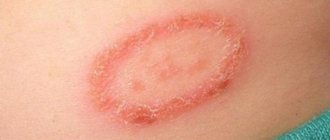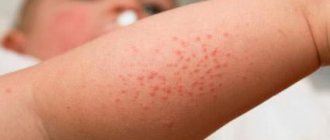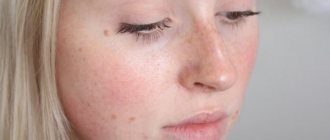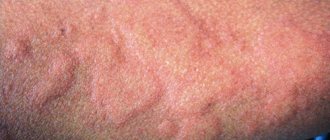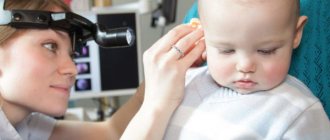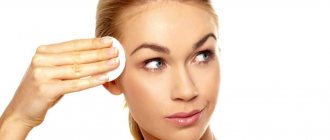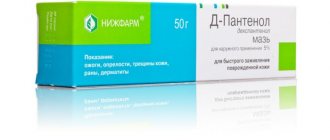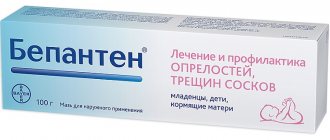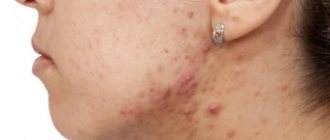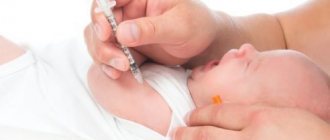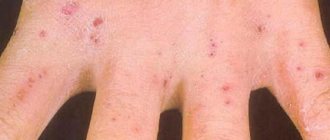801
Human skin diseases. What causes it? Infections or complications due to underlying medical conditions. Let's look at the main human skin diseases with photos and descriptions, to which people with diabetes are more susceptible.
One of the complications of diabetes is numerous skin diseases. Many diabetics are exposed to them very often. Skin diseases that accompany diabetes usually occur due to damage to blood vessels and nerves as a result of hyperglycemia or diabetes mellitus after taking medications. Some of them are not worth paying attention to because they are harmless, others require the help of a dermatologist and can even be life-threatening.
Infectious skin diseases
Infectious skin diseases are more common than others, but can exist in parallel with allergic manifestations.
Bacterial infections
Pyoderma is a superficial bacterial skin infection that includes impetigo, folliculitis, boils, ecthyma and a number of other manifestations. On the skin, it first looks like a raised conical formation with white contents at the top, surrounded by a halo of hyperemia (redness). Then, when rubbed against clothing or scratched, it turns into a wound or erosion with yellow purulent crusts along the edges. Often found on exposed parts of the body, especially the face, arms and legs.
Pyoderma can be caused by several types of bacteria, mainly streptococci and staphylococci. For treatment, doctors usually prescribe antibiotics; for mild forms of the disease, locally in the form of ointments.
It is not recommended to wipe the affected areas with alcohol solutions, since these drugs do not destroy pathogens, but irritate the skin. Instead, antiseptic solutions (fucorcin, dioxidine, chlorhexidine, boric acid) are used for local treatment of inflammatory lesions. Washing with a washcloth is not allowed, so as not to spread the infection throughout the body.
Photo by CDC on Unsplash
Viral infections
Many childhood viral infections are accompanied by viral exanthems, that is, a skin rash. The rash can be caused by measles, rubella, chickenpox, fifth disease (erythema infectiosum), roseola and other diseases.
In addition to these known diseases, there are three more groups of viruses that are characterized by skin rashes: papillomavirus causes warts, poxvirus causes molluscum contagiosum, herpes simplex virus causes shingles and herpes on the lips.
Shingles is a reactivation of the varicella zoster virus. After a person has had chickenpox, the virus lies dormant in the nerves. However, it can become active again, the reasons may be different. For example, if you jog in a wet T-shirt, the virus will become active again, but will no longer cause chickenpox, but shingles. Then a painful rash of small blisters will appear. They are located linearly, most often on one side of the body in the form of a strip. In some cases, the pain may linger for a long time, even after the rash goes away. Shingles most often affects older people and those with weakened immune systems.
Warts are noncancerous skin growths caused by the human papillomavirus (HPV). Warts are more common in children than in adults, although they can develop at any age.
Warts are contagious and can spread to other parts of the body or even to other people. There are as many types of warts as there are types and serotypes of papillomavirus - more than 60. Warts are usually not painful, except when they are located on the legs.
The most common types of warts include the following:
- Common or vulgar warts are growths around the nails and the back of the hands. They usually have a rough surface that is greyish-yellow or brown.
- Plantar warts are located on the soles of the feet with black spots - clotted blood vessels that once fed them. Clusters of plantar warts are called mosaic warts, and they can be painful.
- Flat warts are small, smooth growths that grow in groups of up to 100 at a time. In children, they most often appear on the face.
- Filiform warts are small, long, and narrow growths that usually appear on the eyelids, face, or neck.
- Molluscum contagiosum is a viral disease caused by a poxvirus that most often occurs in children and adolescents, but can also occur in adults. The disease manifests itself as small pink or flesh-colored elements. Over time, a small sunken center develops on the surface of the element. Children typically have two to 20 lesions clustered together. They are not dangerous, but may cause some cosmetic concern due to spreading to the face or other visible areas.
Sometimes warts disappear on their own, overcome by the body's own immunity. But they often increase in size and number and infect other family members. Small and shallow warts are treated with medications containing fluorouracil, salicylic acid, or monochloroacetic acid. If this does not work, the warts are burned with liquid nitrogen. In some particularly difficult cases, warts are removed using a laser.
Fungal infections
Fungi that affect the skin live in the top layer of skin cells in moist areas of the body, such as between the toes or in the groin area and under the diaper. When the normal balance that keeps the fungi under control is disrupted, an infection develops.
Some fungal infections cause only minor irritation, while other types penetrate deeper and cause itching, swelling, blistering or peeling.
In some cases, fungal infections manifest themselves on other parts of the body. For example, a child develops a rash on a finger or hand when the cause is a scalp or foot infection.
Microsporia or ringworm is characterized by ring-shaped red scaly patches with distinct centers. The risk of contracting ringworm increases if a child is in contact with other infected children or animals, especially strays. It only takes petting a cat with ringworm in the yard once to become infected.
Ringworm or microsporia can affect the scalp or body. It often happens like this: to which parts of the body the child applied an infectious kitten or puppy, typical lesions will appear in that place. This dermatosis is highly contagious. It occurs mainly in children between 2 and 10 years of age, but can also occur in adults.
Symptoms of ringworm of the scalp:
- red, scaly rash on the scalp;
- itching of the scalp;
- hair loss;
- rash on the body.
Ringworm of the scalp can develop into a kerion, a round, large formation with characteristic rings in the center.
Ringworm, or microsporia, resembles many skin conditions such as allergic reactions, so always consult your doctor for a proper diagnosis.
Fungal nail infections affect the nails, most commonly the toenails. Damage to the nail plate on the foot is characterized by thickening, deformation, discoloration, and the appearance of a crumbly discharge. Fungal nail infections are rare in young children.
Symptoms of fungal nail infection:
- thickening of the ends of the nails
- yellow nail color
- red round lesion with raised edges, the middle becomes pale as the lesion grows;
- itching
Pityriasis versicolor, or pityriasis versicolor , is a common fungal skin infection characterized by lighter and darker patches on the chest or back. It prevents the skin from tanning evenly and is most common in adolescence and early adulthood.
Typically, the only symptom of pityriasis versicolor is white or light brown spots. They may become slightly enlarged, but rarely itch or hurt. Other common characteristics of the infection include:
- white, pink and brown spots;
- infection only on the upper layers of the skin;
- rash along the trunk of the spine;
- no rash on the face;
- spots worsen in heat or high humidity;
- the spots are most noticeable in summer.
Separately, in this group it is worth talking about Lichen Rosea Gibert, although it has nothing to do with a fungal infection.
Pityriasis rosea is a mild but common skin condition that is characterized by scaly, pink, scaly oval or round lesions. These elements are located on the entire surface of the skin of the body, arms and legs. This condition can last from four to eight weeks, but usually does not leave lasting marks.
The cause of pityriasis rosea is unknown, but it is most likely caused by a virus. The disease usually occurs in children, adolescents, and young adults (more than 75% of people with the rash are between the ages of 10 and 35). In addition, pityriasis rosea more often manifests itself in spring and autumn.
Pityriasis rosea usually begins as a pink or brown oval area, sometimes called the fleur-de-lis or mother's spot, on the chest or back. After the main, or “maternal” spot, after a few weeks, smaller pink spots appear on other parts of the body - the back, neck, arms and legs. The affected areas may be itchy. Pityriasis rosea usually clears up in four to eight weeks without any treatment.
Treatment for fungal skin diseases depends on the type of fungus and the severity of the condition. Local and systemic therapy is usually prescribed, and it is also important to boost immunity. The patient's personal belongings must be processed; it is better to throw away some things (for example, towels) and replace them with new ones.
Diseases of parasitic nature
Skin parasites are small insects that burrow into the skin to live or lay eggs. There are many types of parasitic skin infections that require parental attention, but the most common are scabies and lice.
Scabies is an infestation of tiny mites that is characterized by small, red papules (raised growths on the skin) and intense itching. This highly contagious infection is often spread from person to person when they sleep in the same bed or have close contact.
Ticks burrow into the skin where they lay eggs that hatch within a few days. This is what causes itching. Scabies can affect people of all ages, but occurs mainly in children and young adults.
It may take four to six weeks for a child to develop symptoms of scabies after exposure to an infected person.
In children under two years of age, mite lesions typically appear on the head, neck, palms of the hands and soles of the feet. In older children, the skin between the fingers, hands or wrists, along the waistline, lower back, hips or navel, groin area, chest and armpits is affected.
Symptoms of scabies:
- severe itching;
- rash with small pimples or red bumps;
- scaly or crusty skin in advanced conditions.
Pediculosis
Lice are tiny insects that can infect the skin anywhere, but in children they most often live on the scalp. Pediculosis is characterized by intense itching and is highly contagious. Lice spread from person to person through close contact with the body, through shared clothing and household items such as hats, combs and hairbrushes.
A surge in head lice is not uncommon in day care centers and schools. First, the child's head begins to itch very much, and then parents may notice eggs, usually called nits, among the hair, behind the ears and on the neck.
Methods of infection
The human body contains a huge number of different bacteria. Under the influence of various factors, they provoke various inflammations on the skin.
Among the causes of pathology are the following:
- Hypothermia or overheating, when blood circulation and gastrointestinal tract function are disrupted, and ulcers and cracks appear on the skin.
- Frequent stress.
- Skin damage (insect bites, cuts, scratches, etc.).
- Weak immunity.
- Vitamin deficiency, unhealthy diet.
- Predisposition to allergies.
In young children, pyoderma appears when:
- failure to comply with personal hygiene rules by parents;
- poorly washed or unironed diapers and clothes;
- contact with a patient with pyoderma.
Allergic skin diseases
The most common allergic disease in children is atopic dermatitis.
Atopic dermatitis is characterized by itchy lesions with peeling and crusts, which most often occur on the face, in the folds of the elbows and popliteal folds, on the dorsum of the hands and feet. This condition usually appears in the first year of life and goes through several stages: infancy, childhood, adolescence and adulthood.
Atopic dermatitis is a complex disease. Various genetic and environmental factors are thought to be involved. As a result, children with a family history of allergies are more likely to develop this type of dermatosis.
The itching of atopic dermatitis can be extremely severe and debilitating, to the point of preventing a child from sleeping or playing. It is important to prevent children from scratching their skin, as this can lead to infection.
Most cases of infantile atopic dermatitis are mild, and the vast majority of children outgrow the disease. But, unfortunately, in a certain proportion of children, atopic disease progresses to the childhood and teenage stages.
Atopic dermatitis is a chronic disease that must be constantly monitored. However, there are a few simple steps you can take to help your child feel better:
- Apply an emollient regularly, 2-3 times a day: it will restore the skin and reduce itching;
- dress children in soft clothes;
- Carry out wet cleaning regularly and ventilate the premises more often, if possible;
- avoid exposure to known allergens;
- Wash baby clothes in mild detergents and bathe babies with gentle, unscented soap or soap-free products.
Treatment
Before starting treatment, it is necessary to check whether the child has any concomitant diseases and determine the tolerability of medications. As therapy, the skin is treated, and in severe cases, systemic drugs are prescribed.
Drug treatment
It includes:
- Daily treatment of the affected area with iodine or Fucorcion.
- Wiping the skin with disinfectant solutions (alcohol, boric or salicylic acid).
- Drying the rashes with compresses with potassium permanganate or zinc sulfate.
- Softening the skin with ointment with sulfur or tar. They have an antiseptic and antibacterial effect.
- in the presence of boils, use Vishnevsky or ichthyol ointment. They are applied under the bandage;
- if the disease has become severe or there is severe inflammation, then corticosteroid ointments are used.
In severe cases, the following drugs are prescribed:
- Antibiotics – Ampicillin, Erythromycin.
- If you are intolerant to antibiotics - Biseptol and Norsulfazole.
- To eliminate itching and allergies, antihistamines - Zyrtec, Zodak.
- To increase immunity, immunostimulating drugs - Echinacea, Immunal.
- In the absence of treatment results, it is possible to introduce an autovaccine or staphylococcal bacteriophages. They are aimed at destroying pathogenic microflora.
After an illness, the child is prescribed paraffin therapy or ultraviolet irradiation.
Folk remedies
This method can be used only after consultation with a doctor and in mild cases of the disease. The recipes are aimed at relieving swelling and helping to restore the skin. The most commonly used means:
- Dandelion tincture. For cooking you will need 3 tbsp. l. dandelion root and 1 tbsp. l water. All this needs to be brought to a boil, cooled, and strained. This infusion should be taken orally before meals.
- Celandine. It will take 20 g. celandine and 100 ml. vegetable oil. Everything is mixed and applied to the rash.
- Poplar. 2 tbsp. poplar buds are crushed and filled with 200 ml. vegetable oil. The mixture needs to be left for a day and lubricated on the affected areas of the body 2 times a day.
- Potato. Grate one medium potato, apply the resulting mixture onto gauze and apply to the rash. Carry out the procedure three times a day for 2 hours.
- Aloe juice, which is diluted with water 1:1. The resulting infusion is wiped over the affected area of the skin. It dries and disinfects the affected areas.
- Vaseline and burdock will help soften the skin. To prepare the composition you will need 20 grams. Vaseline and 1 tsp. chopped burdock stem. The ointment is applied to the affected area of the skin.
Damage to the sebaceous and sweat glands
Miliaria - a rash in the form of transparent blisters or red nodules - most often affects infants during the hot season. It occurs due to blockage of the sweat glands and is most often caused by overheating of the body. Treatment of prickly heat involves eliminating overheating: optimal room temperature, weather-appropriate clothing, and hygiene.
Adolescence is characterized by pimples and acne . To understand the nature of acne, you need to know how the skin “works” from the age of 12-14. Next to the pores on the skin are the excretory ducts of the sebaceous and sweat glands. When a child begins to enter adolescence, the amount of sex hormones - androgens - increases. From excess hormones, the sebaceous glands become overactive, enlarge and produce too much sebum or sebum.
When there is too much sebum, the pores and hair follicles become clogged. Increased sebum content leads to excessive growth of bacteria called Propionibacterium acnes, and as a result, acne appears on the face, chest and back.
The very first rule you need to teach a teenager is to wash yourself properly. In this case, it is better to select a cosmetic product for cleansing the skin together with a dermatologist.
Hyperhidrosis, or excessive sweating of the palms and feet, is a common problem in children starting at age 9. There is no reason to panic: this is a physiological condition. To deal with it, you need to follow hygiene rules and apply special gels containing aluminum salts. They gently normalize sweating.
Remember: if you are concerned about your baby's skin, it is important to consult a qualified healthcare professional. He will accurately diagnose the disease and give lifestyle recommendations, as well as prescribe a treatment plan.
Diagnostics
To make an accurate diagnosis, you will need to do a series of laboratory and microscopic studies. To do this, the discharged contents of the pustules are taken for analysis and examined under a microscope. This is how the type of pathogen and its sensitivity to antibiotics are established.
A blood test is also taken, which in case of pyoderma will show an increase in ESR and leukocytes. A blood test is taken to detect the Wasserman reaction (syphilis).
Genetic skin diseases
In addition to those listed, there are also genetic skin diseases, for example, epidermolysis bullosa, which occurs in one child out of 50-100 thousand births. Genetic damage makes the skin of such children fragile, it is injured from any touch and requires very careful handling - because of this they are called “butterfly children”. Today, epidermolysis bullosa is incurable, but with an accurate and timely diagnosis, children can be given proper care and ensure a normal life. Help for such children is provided by the Butterfly Children charity foundation, which recently began working on another genetic skin disease - ichthyosis.
The process of formation of rashes
The incubation period lasts from infection itself to the appearance of the first symptoms - 7-10 days. During this time, bacteria actively multiply and appear as rashes on the body. By nature they can be:
- primary - the rash appears on healthy skin;
- secondary – purulent complication due to existing chronic diseases (prickly heat, eczema). In this case, the pathogen enters through the damaged epidermis.
Newborn babies can become infected:
- from a mother who had foci of infection;
- during childbirth;
- after contact with sick people.
Pyoderma in newborns
It has been clinically established that in early childhood, pustular skin diseases have a number of features. For example, the course of staphylococcal pyoderma in a newborn is usually quite severe, since antibodies are not produced until the 42nd day of life. Infection can occur during pregnancy or during childbirth. Why are staphylococcal pyoderma dangerous in newborns?
- Young children are very susceptible to infection.
- Tendency to generalize (spread) the infectious process.
- There is a high risk of sepsis.
- The skin infection may go away, but the body's overall reaction remains.
The rashes are located superficially. The content can be either transparent or translucent. Most often, vesiculopustulosis is observed, in which the mouths of the sweat glands become inflamed. This inflammation is purulent in nature. If adequate therapy is carried out, deep spread does not occur, infiltration is not observed and the duration of the disease is about one week.
A more severe course is observed in epidemic pemphigus of newborns. There is a rapid spread of surface elements throughout the child’s skin. Large areas of erosion are revealed. If a malignant course is observed, the fusion of erosions in the process of peripheral growth of blisters and skin detachment is determined. The most severe form of pyoderma in newborns is exfoliative dermatitis. There is a rapid increase in bubbles, which burst and form significant erosion. In parallel with the rash, high fever, weight loss, and diarrhea are recorded. Pneumonia, otitis media and sepsis may occur.
Types of infection
Today there are a large number of types of this infection:
- Streptococcal impetigo;
- Bullous impetigo;
- Slit-like impetigo;
- Erythematosquamous impetigo;
- Tourniol;
- Streptococcal diaper rash.
All these types of infections are united by the presence of one pathogen, which affects the child’s body differently and causes various purulent-inflammatory diseases.

